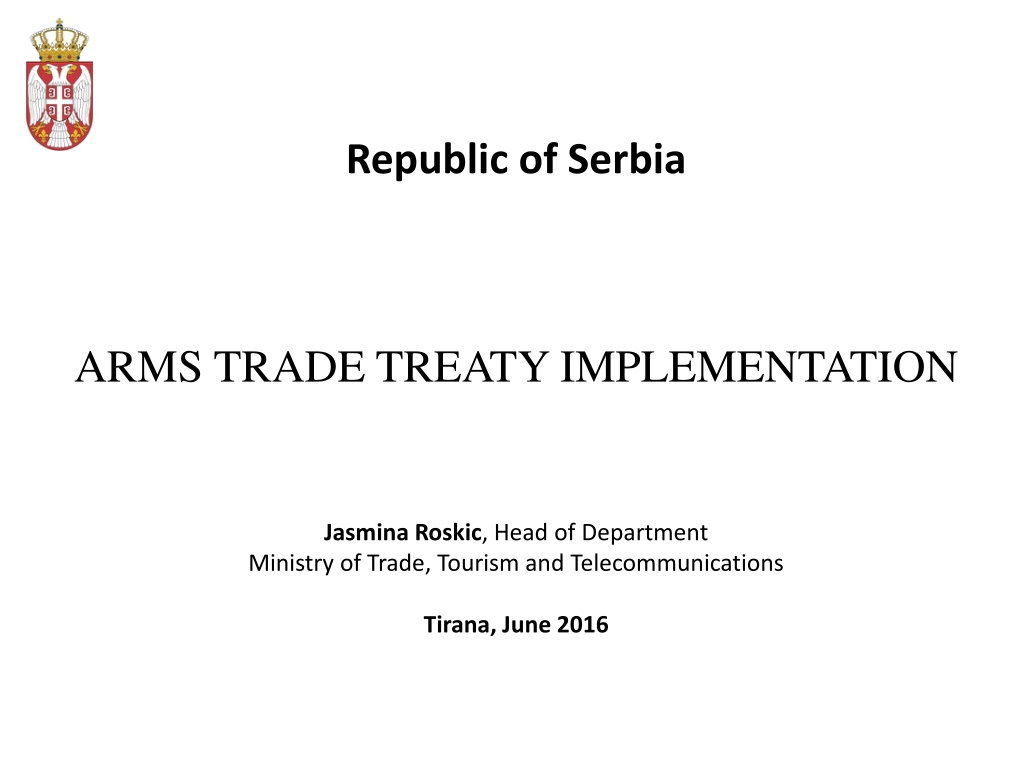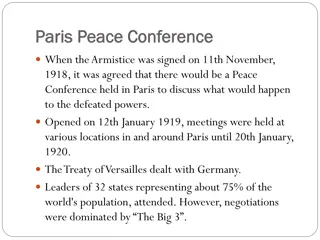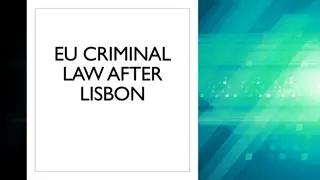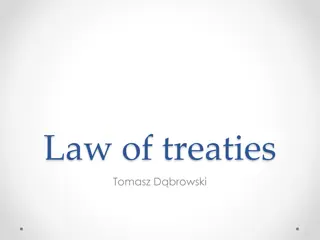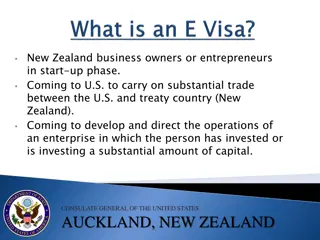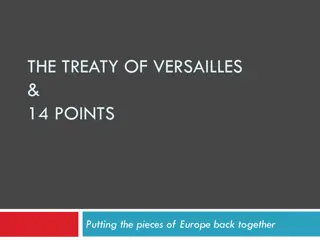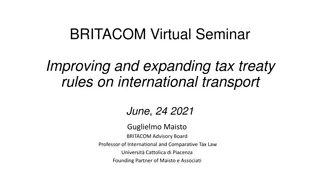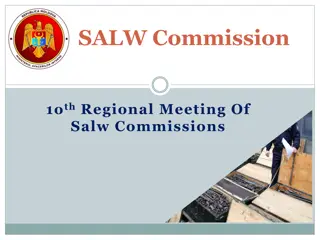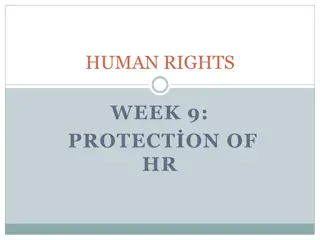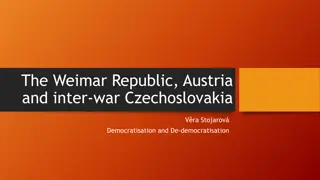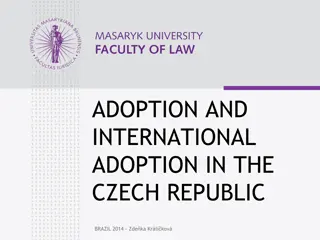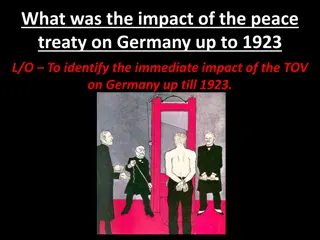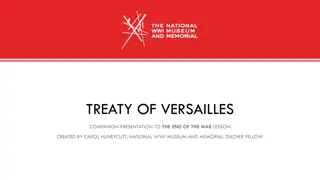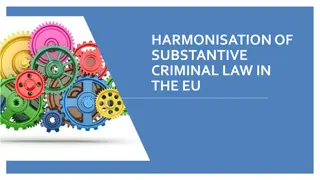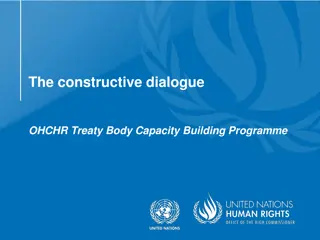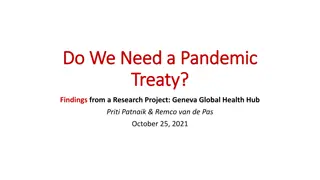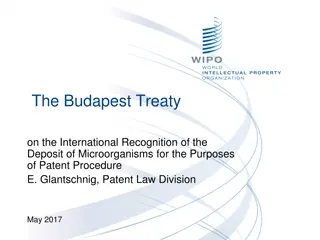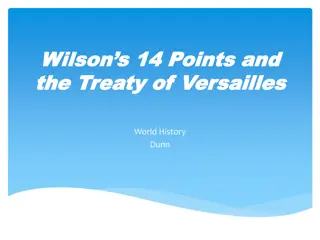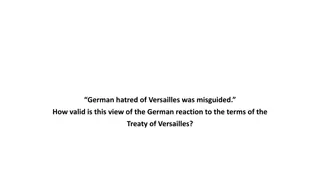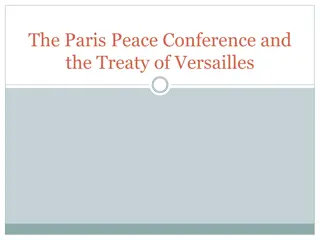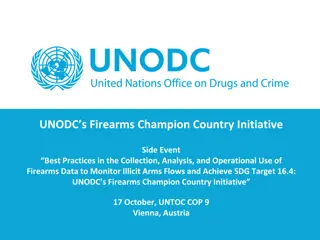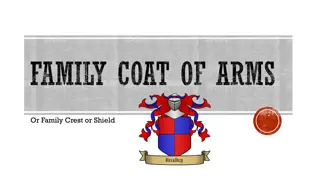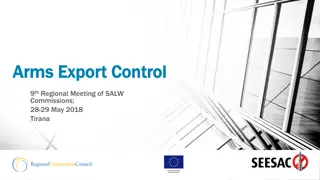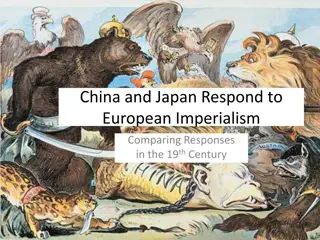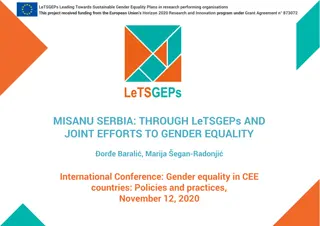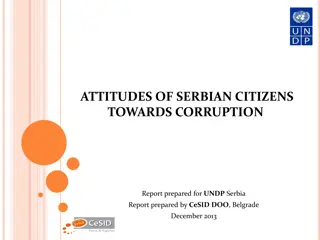Implementation of Arms Trade Treaty by Republic of Serbia
The Arms Trade Treaty (ATT) was ratified by the Republic of Serbia in October 2014 and entered into force on December 24, 2014. The treaty aims to establish international standards for regulating the international trade in conventional arms, covering activities such as exports, imports, transit, trans-shipment, and brokering. It lists eight categories of arms to which the treaty applies, with provisions encouraging states to apply the treaty to a broader range of conventional arms. The control of exports extends to ammunition, munitions, parts, and components.
- Arms Trade Treaty
- Republic of Serbia
- International Trade Regulations
- Conventional Arms
- Export Control
Download Presentation

Please find below an Image/Link to download the presentation.
The content on the website is provided AS IS for your information and personal use only. It may not be sold, licensed, or shared on other websites without obtaining consent from the author. Download presentation by click this link. If you encounter any issues during the download, it is possible that the publisher has removed the file from their server.
E N D
Presentation Transcript
Republic of Serbia ARMS TRADE TREATY IMPLEMENTATION Jasmina Roskic, Head of Department Ministry of Trade, Tourism and Telecommunications Tirana, June 2016
ARMS TRADE TREATY ATT entered into force on December 24, 2014, in accordance with its Article 22 (ninety days following the date of the deposit of the fiftieth instrument of ratification). The Republic of Serbia ratified ATT in October 2014, before its entering into force ( Official Gazette of RoS - International Agreements , no.14/14)
SCOPE Object of the Treaty - to establish highest possible common international standards for regulating or improving the regulating of international trade in conventional arms (Article 1). Regulate means control the transfer of specifically identified, sensitive items to make sure that the items do not end up in the wrong hands. The scope of the controls: (1) activities (2) items.
SCOPE (cont.) The purpose of the Treaty is to regulate international trade (Article 1). According to Article 2 international trade comprises: Export, Import, Transit, trans-shipment and Brokering All these activities are referred to as transfer in the Treaty.
ITEMS Article 2.1 lists the eight categories to which the Treaty applies: Battle tanks; Armoured combat vehicles; Large-calibre artillery systems; Combat aircraft; Attack helicopters; Warships; Missiles and missile launchers; and Small arms and light weapons. Exports of ammunition and of parts/ components are controlled only under Articles 6 and 7.
ITEMS (con.) The scope defined in the ATT is a floor . Article 5.3: the States Parties are encouraged to apply the provisions of this Treaty to the broadest range of conventional arms , i.e. beyond the eight listed categories. Confirmed by the requirement that national definitions of the first seven categories shall not cover less than the descriptions used in the United Nations Register of Conventional Arms . Article 5.3, the text specifies that national definitions of the eighth category (SALW) shall not cover less than the descriptions used in the relevant United Nations instruments at the time of entry into force of the Treaty .
The control of exports goes further; Export of ammunition, munitions, parts and components must be controlled - covered by Articles 3 and 4. Each State Party shall establish and maintain a national control system to regulate the export of ammunition, parts and components and shall apply the Articles 6 and 7 prior to authorizing the export. Other activities-just calls to apply the Articles 6 and 7.
ATT CRITERIA A two-stage approach; first consider the Prohibitions under Article 6, and only if none of them apply, conduct a risk assessment under Article 7 Article 6 prohibits export if it will breach the arms embargo or other international obligations by the State. The exporting State shall not authorize the export if, after conducting the assessment and considering available mitigating measures it determines that there is an overriding risk of any of the negative consequences EU Common Position 944/2008- the potential export might
CRITERIA (con.) Article 7 is mainly covering the ground covered by Criterion 2 (human rights), Criterion 3 (internal conflicts in the destination country), and Criterion 4 (Preservation of regional peace, security and stability) of the EU Common Position. However, it sets less demanding tests.
Pros and Cons using the ATT criteria IN FAVOUR: Meets the minimum standards required to ratify ATT; AGAINST: Less ambitious; less cases will be refused, thus meaning a less positive contribution to counter-proliferation; Narrower coverage; ATT criteria are specific to military goods and say nothing about WMD risk;
Pros and Cons using the Common Position Criteria AGAINST: Goes beyond what ATT requires and sets more stricter tests. IN FAVOUR: Broader coverage and stricter tests One set of criteria cover both conventional and WMD risk;
IMPORT States Parties shall adopt measures to regulate, where necessary, imports of conventional arms. (The Treaty also provides that such measures may include import systems, but it does not provide further guidance on such systems.) States Parties can also adopt measures to regulate the import of ammunition and parts and components, although the ATT does not explicitly require them to do so. States Parties shall prohibit the importation of conventional arms ammunition, parts and components if such importation would violate Article 6 of the Treaty.
Transit or trans-shipment The ATT does not provide a definition for transit and/or trans shipment. According to the International Small Arms Control Standards (ISACS), transit and trans shipment are: Transit: Movement of goods across the territory of a State as part of a transfer between two other States, including the trans loading of the goods at the points of entry into and exit from the transit State . Trans shipment: Transport of goods to an intermediate location outside the exporting and importing States, where they are loaded to a different transport vessel and transported to their final destination (or additional point of trans shipment) without crossing the territory of the State in which the trans loading takes place. Trans shipment usually takes place in transport hubs at ports and often takes place within designated customs areas, which are not subject to customs checks or duties . States Parties have the prerogative to adopt measures to regulate the transit or trans shipment of ammunition and parts and components, even though the ATT does not explicitly require them to do so. Measures to regulate transit and trans shipment shall be taken in accordance with relevant international law.
BROKERING The competent national authorities tasked with regulating brokering of conventional arms should be clearly identified in the national legislation. Although it is a prerogative of each State Party to decide which authorities should be entrusted with the responsibility of regulating brokering, it would be consistent with ATT implementation obligations to consider placing that responsibility with the same authorities entrusted with the regulation of exports.
BROKERING (con.) Serbian Law on Export and Import of Arms and Military Equipment (Official Gazette RoS no.107/14)-Article 3.paragraph 1 point 6 Brokerage servicesare negotiating and mediating in negotiation deals relating to purchase, sale or procurement of AME from one country and them being sold in another country, as well as sale or purchase of AME in one country for the purpose of them being transferred to another country. Registration and extraterritoriality-up to national legislation. The regulation of extraterritorialbrokering is consistent with the rights of States Parties under the ATT. That contributes to the establishment of the highest possible common international standards in the regulation of the international trade in conventional arms. exercising control over extraterritorialbrokering would facilitate mutual legal assistance and extraditions between States concerned, consistent with Article 15(5), which obliges States to afford one another the widest measure of assistance in investigations, prosecutions and judicial proceedings in relation to violations of national measures established pursuant to this Treaty.
DIVERSION The ATT does not provide a definition of diversion-call the State Parties to take measures to prevent the diversion of conventional arms. In general terms, diversion is the transfer of items from an authorized owner/user to an unauthorized user. Diversion can take place when items are intended for export to one end user, but instead they are delivered to another, unauthorized, end user. Diversion of weapons is a key method by which States under arms embargo, human right abusers, terrorists and organized criminal groups obtain weapons.
DIVERSION (cont.) The prevention of diversion is one of the cornerstones of the ATT. Each State Party involved in a transfer of conventional arms (exporting, transit/trans shipment and importing States) shall adopt measures to prevent diversion. While the ATT does not require State Parties to take measures to prevent diversion of ammunition or parts and components, each State Party is free to adopt such measures. Exporting, transit/trans shipment and importing States Parties shall cooperate and share information, pursuant to their national laws, to mitigate the risk of diversion of arms transfers. When a State Party detects diversion of transferred weapons it should also alert potentially affected States Parties. State Parties should share information on their experiences in addressing diversion.
ATT obligations: Record keeping Maintain national records on export authorizations or actual exports of conventional arms for 10 years, pursuant to national laws and regulations Optional provisions Maintain records of imports of conventional arms for 10 years Maintain records of authorizations for transit or trans-shipment of conventional arms covered in Article 2 (1) for 10 years Records should contain the following information: quantity, value, model/type, exporting State, importing State, transit and trans-shipment State(s) and end-users as appropriate for authorized transfers and actual transfers
RECORD KEEPING (cont.) Obligations Initial report to the Secretariat on measures undertaken to implement the ATT, including national laws, national control lists and other regulations and administrative measures, to be submitted within the first year after entry force . Additionally: Report to the Secretariat on any new measures undertaken Annual report to the Secretariat by 31 May a report for the preceding calendar year concerning authorized or actual exports and imports of conventional arms covered under Article 2 (1) Optional provisions Report to other States Parties, through the Secretariat, information on effective measures in addressing diversion of transferred conventional arms
Records and data to be kept Recommended by Treaty: quantity, value, model/type, exporting State, importing State, transit and trans-shipment State(s) and end-users Others? E.g. parts in the transaction, brokers Use? Reporting template-possibilities for different interpretation Initial report-based on the ATT Baseline Assessment Product Annual report: based on the UN Register of Conventional Arms (UNROCA)
RECORDS AND DATA (cont.) Options for the State Parties to report on: - authorized or actual export and import - number of items or financial value - voluntary national categories of conventional arms - additional data (e.g.type of end users) and additional categories (ammunition and parts/components) - exclusion of commercially sensitive or national security information Reporting on ATT is obligatory
The reporting Situation June 10,2016 Initial report: 48 initial reports out of 82 States Parties (59%) Albania, Australia, Austria, Belgium, Bosnia and Herzegovina, Bulgaria, Burkina Faso, Costa Rica, C te d'Ivoire, Croatia, Czech Republic, Dominican Republic, Estonia, Finland, France, Germany, Hungary, Iceland, Ireland, Italy, Jamaica, Japan, Latvia, Liechtenstein, Lithuania, Luxembourg, Macedonia, Mexico, Montenegro, Netherlands, New Zealand, Nigeria, Norway, Poland, Portugal, Romania, Samoa, Senegal, Serbia, Sierra Leone, Slovakia, Slovenia, South Africa, Spain, Sweden, Switzerland, Trinidad and Tobago, United Kingdom 46 out of 48 initial reports are publicly available (Serbia) Annual report: 33 annual reports out of 82 States Parties (40%) Albania, Argentina, Australia, Bosnia and Herzegovina, Bulgaria, Costa Rica, Czech Republic, Dominican Republic, Estonia, France, Germany, Hungary, Italy, Latvia, Liechtenstein, Macedonia, Mexico, Netherlands, New Zealand, Norway, Portugal, Republic of Moldova, Romania, Samoa, Senegal, Serbia, Slovakia, Slovenia, South Africa, Spain, Sweden, Switzerland, United Kingdom 31 out of 33 annual reports are publicly available (Serbia)
Implementation of ATT-Summary Clear and precise legislation covering all the ATT transfers and incorporating decision-making criteria and a control list A recognized competentauthority with trained licensing staff and an enforcementauthority Clear responsibilities Technical input Mechanisms to harness all relevant information within the competent authority, across government, and internationally Effective enforcement
www.mtt.gov.rs izvoznakontrola@mtt.gov.rs THANK YOU FOR YOUR ATTENTION jasmina.roskic@mtt.gov.rs
